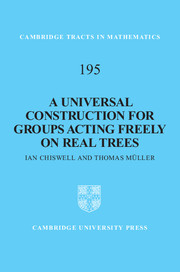Book contents
- Frontmatter
- Contents
- Preface
- 1 Introduction
- 2 The group ℛF(G)
- 3 The ℝ-tree XG associated with ℛF(G)
- 4 Free ℝ-tree actions and universality
- 5 Exponent sums
- 6 Functoriality
- 7 Conjugacy of hyperbolic elements
- 8 The centralisers of hyperbolic elements
- 9 Test functions: basic theory and first applications
- 10 Test functions: existence theorem and further applications
- 11 A generalisation to groupoids
- Appendix A The basics of Λ-trees
- Appendix B Some open problems
- References
- Index
4 - Free ℝ-tree actions and universality
Published online by Cambridge University Press: 05 November 2012
- Frontmatter
- Contents
- Preface
- 1 Introduction
- 2 The group ℛF(G)
- 3 The ℝ-tree XG associated with ℛF(G)
- 4 Free ℝ-tree actions and universality
- 5 Exponent sums
- 6 Functoriality
- 7 Conjugacy of hyperbolic elements
- 8 The centralisers of hyperbolic elements
- 9 Test functions: basic theory and first applications
- 10 Test functions: existence theorem and further applications
- 11 A generalisation to groupoids
- Appendix A The basics of Λ-trees
- Appendix B Some open problems
- References
- Index
Summary
Introduction
The simplest case of Bass-Serre theory, which describes the structure of a group acting on a (simplicial) tree in terms of standard constructions of geometric group theory, occurs when the action is free. In Bass-Serre theory, one assumes that no group element is an inversion, that is, no group element interchanges the endpoints of an edge. This is needed to ensure that one can form the quotient graph for the action. From another viewpoint, if one forms the geometric realisation of the tree, so that each edge corresponds to a copy of the compact real interval [0, 1], the induced action will not be free if there are inversions, as an inversion will fix the midpoint of the corresponding interval. is a consequence of Bass-Serre theory (although the result is much older, going back at least to Reidemeister and the early 1930s) that a group acts freely and without inversions on a tree if and only if it is a free group.
Given a simplicial tree T, there is a corresponding ℤ-tree (X, d), where X is the set of vertices of T and d(x, y) is the length of the unique reduced path in from x to y; the length of a path being the number of edges in it. Moreover, all ℤ-trees arise in this way (see Example A.8). It is easy to see that a graph automorphism of T is an inversion if and only if the corresponding isometry of (X, d) is an inversion in the sense of the previous chapter (see Definition A.48).
- Type
- Chapter
- Information
- Publisher: Cambridge University PressPrint publication year: 2012



